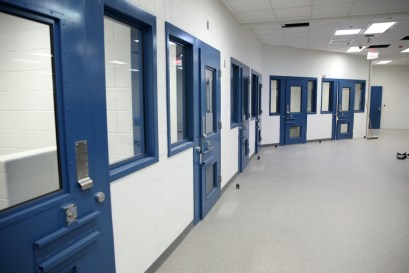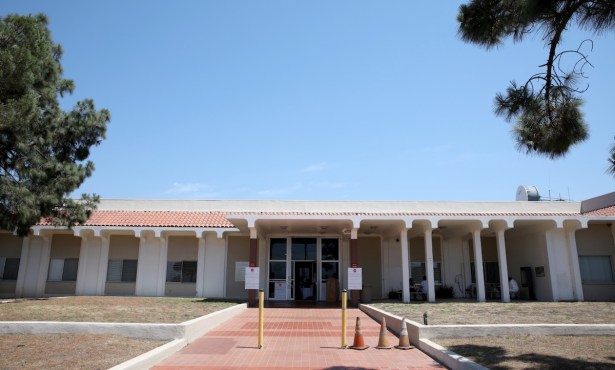Supervisors Push to Reengineer Santa Barbara’s Criminal Justice Machine
Can Savings from Jail Be Used to Fund Prevention Programs Instead?

As of April 9, there were only 635 inmates in the Santa Barbara County Jail. From February 2020 to February 2021, the average daily count was lower still — just 611 inmates. For the three county supervisors most intent on dramatically reengineering Santa Barbara County’s sprawling $400 million criminal justice machine, these numbers are bursting with staggering possibility.
That’s because in a typical non-COVID year, the county jail — until recently the focus of protracted jail overcrowding litigation — was home to about 1,000 inmates.
Even as the COVID curtain lifts, Supervisors Gregg Hart, Das Williams, and Joan Hartmann are pushing hard to keep the jail population down. Their plan is to spend the savings derived from cuts to the jail’s budget to fund a host of programs — prevention, mental health, and rehabilitation — to help keep people out of jail entirely.
At an all-day public hearing on this upcoming year’s budget held Monday, April 12, Supervisor Williams threatened to vote against any budget plan that did not make substantial cuts to operations at the county’s main jail. With the new North County Jail about to open up, he said Sheriff Bill Brown could make significant cuts to the main jail, specifically to two of the wings where expensive repairs are required. For far too long, Williams charged, the supervisors have been “shoveling millions and millions into keeping people incarcerated.” “I want a plan,” he repeatedly stated to Brown. Earlier in the day, he and District Attorney Joyce Dudley traded exchanges on much the same theme.
While none of the other supervisors were so nakedly confrontational in their approach, Hart and Hartmann made it clear the status quo wouldn’t suffice when it came to incarceration and diversion rates. Clearly, the specter of George Floyd hovered over the day’s deliberations, adding a new sense of urgency to questions that have long simmered about Santa Barbara’s criminal justice system. So too, obviously, was the threat of COVID, without which the reductions to the county jail populations — “dramatic and drastic” in Brown’s words — would never have occurred.

Neither Brown nor Dudley was about to roll over; both insisted they already were actively engaged in diversionary efforts. Dudley claimed it was she who brought diversion to the county nine years ago, while Brown insisted, “This is not some flash in the pan,” after he had outlined various jail-based education and rehab programs. Brown warned the supervisors that the jail’s population is now artificially low, and that the crime rate is already on the rise.
Brown also sought to dispel the impression that the county jail was bursting with low-level offenders. Of the 635 there on April 9, he said 68 were charged with murder or attempted murder; 592 were accused of felony-level crimes. Only 41, he said, were facing misdemeanor charges.
Both Brown and Dudley, it should be understood, are independently elected by the voters and do not answer to the supervisors on how they run their departments. The supervisors do, however, wield the power of the purse. This week’s weeklong budget preview qualifies as a dress rehearsal for the down-and-dirty deliberations that will take place later this summer.
For the first time ever, the county’s executive officers, led by Mona Miyasato, scheduled a special hearing to brief the supervisors exclusively on jail diversion programs. In fact, Miyasato — always careful to remain above the political fray — has convened an ongoing Criminal Justice Working Group and appointed a retired judge to head it to examine just such issues.
MEASURE TWICE, CUT ONCE
If the supervisors found themselves to be confused as to basic facts at the end of Monday’s nine-hour meeting, they are to be excused. Statistics flew fast and furious from every vantage point.
Public Defender Tracy Macuga — who described the current system as the judicial equivalent of “a conveyor belt” — used one set of numbers, while DA Dudley stressed that her deputies pursue diversionary opportunities “whenever and wherever appropriate.” Defendants charged with misdemeanor-level drunk driving and domestic abuse, for example, are not eligible for diversion.
Williams pushed Dudley, arguing that a larger number of misdemeanor charges involved people facing minor drug charges, driving with suspended licenses, and public intoxication. Dudley pushed back, stating that the lack of consideration afforded crime victims during Monday’s deliberations “hurts my heart.” She said her deputies evaluate candidates based on a totality of factors, including other crimes in which they’ve been involved. “I will never make a decision based on the numbers,” she stated.
Macuga and her staff reported that only 11 percent of all cases are set aside for one of the county’s eight diversion programs. Macuga also noted that 85 percent of all the cases filed by the DA’s Office were misdemeanor cases, a number, she said in a gathering of mental-health advocates last week, that “should shock the conscience.”
Her deputies talked of spending 10-12 hours per brief on legal filings submitted on behalf of clients whose infractions stemmed largely from mental-health or substance-abuse issues. They complained of having to wage legal battle with their counterparts in the DA’s Office to get clients into treatment programs rather than jail. In the meantime, they charged, it would take four months to get a schizophrenic client who hears voices an appointment to see a psychiatrist.
Ann Bramsen, an experienced criminal prosecutor, painted an entirely different picture. Of 87 case filings she handled over a three-week timespan early this year, she said, 52 of the defendants had their charges dropped, reduced to infractions, or placed in a jail-diversion program. Chief Deputy DA John Savrnoch stated 55 percent of all cases referred for criminal prosecution were removed from the traditional criminal justice system in 2020.
Supervisor Williams commented on the “incongruity” of the information the supervisors were given — how was he supposed to square the 11 percent the supervisors had been told earlier in the hearing with the 55 percent they were told later in the day?
Supervisor Hart’s frustration was more palpable. “There’s no information I can look at in advance. There’s no way I can verify these numbers,” he complained. Everyone testified they support diversion and agreed they could do more, he said. “So why aren’t we doing more?” he demanded.
For years, the criminal justice system has been the statistical equivalent of a big black box. Law enforcement agencies have complained of being hampered by antiquated data management systems that rendered any efforts to share meaningful breakdowns on who’s behind bars and for what prohibitively labor-intensive. In the wake of COVID, old-school record keeping became not just technically archaic but medically threatening.
New ways were forced upon all members of the criminal justice partnership. In the wake of George Floyd, uncomfortable questions relating to systemic racism within the criminal justice system became much harder to ignore.
In Yolo County, Macuga told the supervisors, a very conservative DA led the charge to create a statistical dashboard that could show at any given time how many people were in county jail and on what charges, their races, and their opportunities for diversion. Such a tool, Macuga argued, would lay to rest impressionistic and anecdotal perceptions about Santa Barbara’s criminal justice system. For example, if criminal defendants in North County actually do get hit with tougher charges and longer sentences for the same crimes and have fewer available diversionary services — as Macuga contends is the case — such a dashboard would lay out the facts.
Such a dashboard won’t be enough to satisfy the activists who urged the supervisors to slash the Sheriff’s budget by $26 million, but it was clearly the crucially needed first step. As basic as it sounds, it will prove to be more challenging than it seems. While all the criminal justice partners — Macuga, Brown, Dudley, and Probation Chief Tanja Heitman — expressed support for such a data-sharing endeavor in concept, that support was far from unequivocal.
Dudley expressed concern about the accuracy of some of the data in the system; if the supervisors set public policy based upon erroneous information, she warned, public safety could suffer. Brown, likewise, expressed some concerns about data accuracy. Heitman, by contrast, suggested her department’s database could provide a valid starting point.
In the 60 days before the supervisors meet again to discuss diversion and the county jail, this is one nail they hope to have nailed down.
While North County supervisors Steve Lavagnino and Bob Nelson expressed concern about the spike in violent crimes Brown warned about, both expressed interest in making fundamental changes to what they described as “the status quo.”
Nelson, new to the board and as the sole Republican the most obviously conservative, expressed pride the board was tackling such big issues. “We’re swinging for the fences with this one,” he said, adding, “We’re the 800-pound gorilla; we have the purse strings. Maybe we have the political will to tie it all up with a bow.”
Support the Santa Barbara Independent through a long-term or a single contribution.




You must be logged in to post a comment.